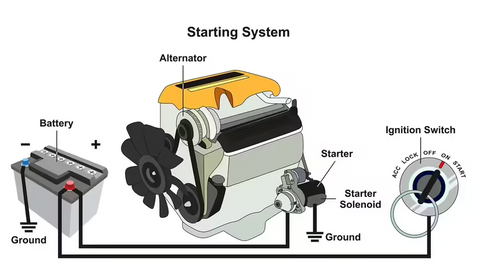How to Test an Alternator with a Multimeter
Introduction:
An alternator is a vital component of a car's electrical system, responsible for charging the battery and powering various electrical components while the vehicle is running. If you suspect that your alternator may be faulty, testing it with a multimeter can provide valuable insights into its condition. In this blog, we will guide you through the process of testing an alternator using a multimeter, allowing you to diagnose potential issues and ensure the optimal performance of your car.
Understanding the Alternator:
Before diving into the testing process, let's briefly understand the role of an alternator. An alternator is a device that generates AC power at a specified frequency. It consists of two main parts: the rotor and the armature coils. The rotor, powered by the car engine, creates a rotating magnetic field, while the stationary armature coils generate electricity through electromagnetic induction.

Signs of a Bad Alternator:
Recognizing the symptoms of a failing alternator is crucial. Look out for the following indicators:
- Car won't start consistently.
- Car won't holda charge.
- Car's electricalsystem flickers.
- Car's batteryhas corrosion.
- Low voltage iconis illuminated.
- Battery smellslike rotten eggs.
- Battery appears swollen.
- Battery is morethan 3-5 years old

Testing the Alternator with a Multimeter:
Please note that Tesmen TM-510 cannot be used to test the current output of an alternator. However, it can provide valuable information about the voltage and assist in diagnosing potential problems. Here's how to proceed:

Step 1: Checking the Car Battery Voltage:
Turn off the car engine.
Connect the red probe to the VΩmA socket and the black probe to the COM socket on the multimeter.
Attach the positive (red) and negative (black) leads of the multimeter to the corresponding terminals of the car battery.
Note the voltage displayed on the multimeter, which should be around 12-13 volts. If it's below 12V, charge the battery before proceeding.
Start the car and recheck the battery voltage while the vehicle is running. The voltage should be approximately 14-15 volts if the alternator is functioning correctly.
Step 2: Loading the Car's Electrical System:
Keep the car running and measure the battery voltage as described in Step 1.
Turn on all heavy electrical loads, such as lights, radio, fan, and heater blower motor.
Reconnect the multimeter's leads to the battery terminals and observe the displayed voltage.
Compare this voltage with the reading from Step 1. If it drops significantly below 13 volts, it may indicate that the alternator is struggling to meet the electrical system's demands.
Step 3: Checking the Alternator Directly:
Locate the alternator within your vehicle and ensure the belt is not loose.
Start the car engine and verify that the alternator belt is spinning properly without slipping.
Set your multimeter to the DC voltage range and connect the positive (red) lead to the red-colored terminal of the alternator.
Touch the negative (black) lead of the multimeter to a metallic part of the car frame (avoid grounding it to the alternator itself).
Observe the multimeter display. A reading of around 13-14 volts indicates a properly functioning alternator. If the reading is excessively high (above 15V), it may suggest a faulty voltage regulator. If it's below 13V, further investigation is needed.
Important Note: Disconnecting the Battery from the Car:
Disconnecting the battery while the car is running is not recommended, as it cancause severe damage to the alternator. This method should only be used in emergencies and with caution.
Conclusion:
Testing an alternator with a multimeter can help you identify potential issues and ensure the smooth operation of your vehicle's electrical system. By following the steps outlined in this blog, you can effectively assess the alternator's condition and make informed decisions regarding maintenance or replacement. Remember to pay attention to the symptoms of a bad alternator and regularly check your car's electrical system to catch any problems early on. If you're unsure or encounter persistent issues, it's always advisable to consult a professional mechanic for expert assistance.

